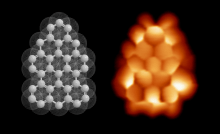Related news by tag José Ignacio Pascual
Nanomagnets made of graphene for faster and more sustainable information technologies

The meeting marks the starting point of a 4-year research project that is coordinated by CIC nanoGUNE and integrates IBM Research, Donostia International Physics Center, and University of Santiago de Compostela, Technical University of Delft and the University of Oxford. The consortium of these 6 leading European research institutions has been granted a total of €3.5 million from the European Commission under the highly competitive Horizon 2020 FET-Open call, which funds cutting-edge high-risk / high-impact interdisciplinary research projects that must lay the foundations for radically new future technologies.
The SPRING project combines recent scientific breakthroughs from the consortium members to fabricate custom-crafted magnetic graphene nanostructures and test their potential as basic elements in quantum spintronic devices. The targeted long-term vision is the development of an all-graphene – environmentally friendly – platform where spins can be used for transporting, storing and processing information.
The spin is an intrinsic property of electrons that makes them behave like tiny magnets. For instance, every electron in any material carries both a charge and a spin, the latter playing a key role in magnetism.
Within the scientific community there is consensus that spin is the ideal property of matter to expand the performance of current charge-based nanoelectronics into a class of faster and more power-efficient components, being the basis for the emerging technology called quantum spintronics. The SPRING project will investigate the fundamental laws for creating and detecting spins in graphene, this is to read and write spins, and using them to transmit information.
Jose Ignacio Pascual, Ikerbasque Research Professor at CIC nanoGUNE and scientific coordinator of the project, explains that “graphene is ideal to host spins and to transport them. This atomically thin material can now be fabricated with atomic precision, opening the door to fabrication of designer structures with precise shape, composition, spin arrangement, and interconnected by graphene electrodes for electrostatic or quantum gates. The potential is a platform for the second quantum revolution as qubit elements for quantum computation.”
Unraveling the magnetism of a graphene triangular flake

In a new study, published in Physical Review Letters [1], this challenge was revisited using a scanning tunneling microscope (STM). After assembling a triangular-like piece of graphene on a clean gold surface, high-resolution scanning tunneling spectroscopy measurements revealed that this compound has a net magnetic state characterized by a spin S=1 ground state and, therefore, that this molecule is a small, pure carbon paramagnet. These results are the first experimental demonstration of a high-spin graphene flake.
The findings were further complemented with atomic manipulation steps of hydrogen-passivated triangulene side-products occasionally found in the experiment. By controlled removal of these additional hydrogen atoms in the experiments, the spin state of the flake could be modified from a closed-shell, doubly hydrogenated structure, to an intermediate S=1/2 spin state, and finally to the high-spin S=1 state of the ideal molecular structure.
The experimental proof of a spin-state in the absence of a magnetic quantization axis (detectable by spin-polarized STM) or magnetic anisotropy (detectable by spin-flip inelastic tunneling spectroscopy) is not simple. In this work, the spin signature was obtained from the underscreened Kondo effect – an exotic version of the standard Kondo effect described in the 1960s – that can arise in high-spin systems. Its observation in a graphene flake on a metal has not been reported before and brings here novel insights to understanding spins interacting with surfaces.
The work was the result of a fruitful collaboration between theoretical and experimental groups at the Donostia International Physics Center (DIPC) and CIC nanoGUNE, both research institutes in San Sebastian, as well as an organic synthesis group at CiQUS, in Santiago de Compostela.

